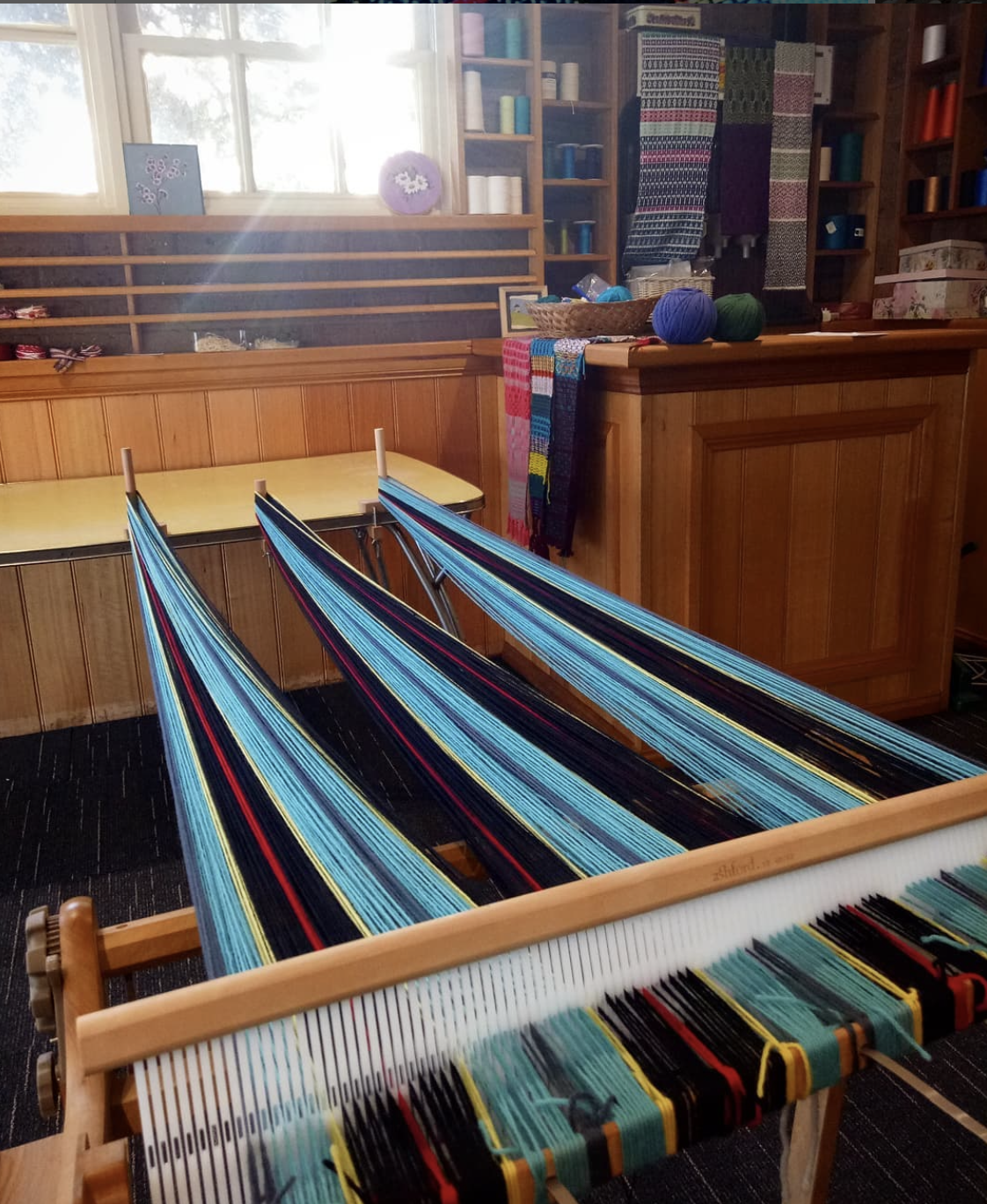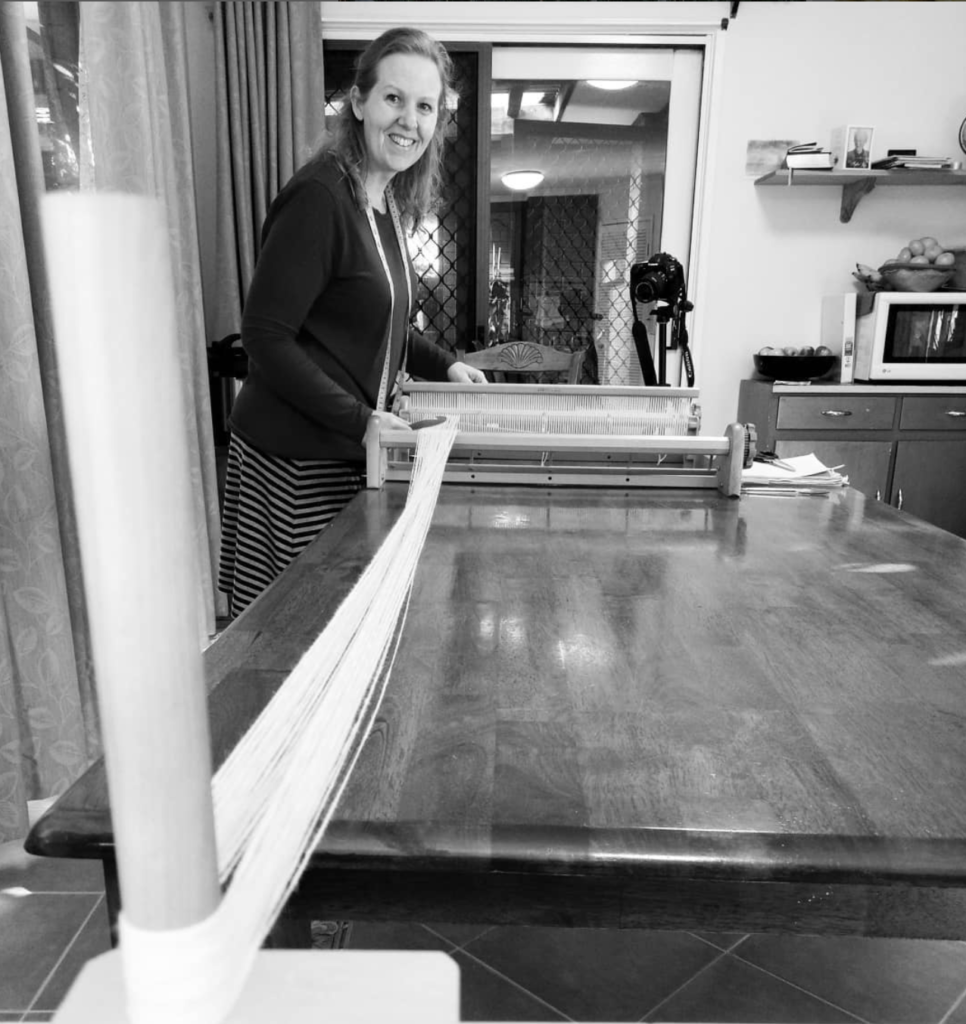Today’s question is in two parts, but both are related to direct warping a rigid heddle loom.
Personally, I love direct warping, it’s one thing that makes the rigid heddle loom so attractive to me. Direct warping is fast and efficient and I just love it.
Starting out direct warping can be made more painless when someone has shared the best tips and tricks with you, and that is where I come in!
This post contains affiliate links. For further information, please see my disclosure policy.
Read on to find out some of my tips for more successful direct warping.
“Hi Kelly!
Can you help me with two problems I had with warping for a baby blanket when the warp has to be 62 inches? I’m working on a Ashford rigid heddle – 24 inch with acrylic worsted yarn and 7.5 10/30 shaft/heddle.
- When winding the yarn, the peg can’t hold the yarn – I have to start overlapping it to get it all on the peg, plus I’m having great difficulty in not pulling too hard on each strand so it doesn’t pull the peg off the table. If I go loose, then I have terribly loose first warp thread that I have to tighten and the next and the next….so I lose a lot of yarn and time.
2. When taking the yarn off the peg and winding on to the back bar, I tried to hold the yarn myself – which I have done successfully for shorted warp length (I’m single and there’s no one else in the house)…didn’t work well because the middle yarns became too loose. Do I just need to get someone else to hold the yarn while I wind the back bar? How else to do this?
Greatly appreciate your help…“
Elizabeth
Hi Elizabeth,
From what you describe, I’m seeing a few potential issues:
1. Acrylic yarn. Acrylics are so varied that sometimes you don’t know what you’re going to get. I’ve heard of some weaver’s warping disasters where the acrylic actually stretches as they’re trying to tension and they end up with a saggy mess no matter what they try.
I have used a few acrylics but not a lot. It has mostly been a positive experience for me, but admittedly they are not my yarn of choice for a bunch of reasons. I think the key to using acrylics successfully is to know your yarn before warping a project with it. The only way you can really know a yarn you’re not familiar with is by sampling. You only need to do this once for a new yarn, then you can determine whether it’s really going to be suitable for your project or not.
2. The weight of your yarn. It sounds to me like the weight is going to be too heavy for a 10 dent reed. Did you do a sett test before starting?
3. Single peg. If your yarn is overlapping on the peg, a second peg would be ideal. Then you can place half of the warp on one peg and the second half on another. This helps distribute all of those threads and will also help to alleviate the other problem you were having – loose middle yarns as you’re warping.
Additional tips:
When warping by yourself, you do need to pay particular attention to that mid section of warp because you are clenching the warp threads all together and the outer threads will naturally be more tensioned than the threads all buried in the middle of your hand. Take your time with the warp, roll a little bit and then go back to the front of the loom, finger comb and re-tension the warp before going to the back to roll again. If you just roll and roll, you don’t have time to nurture the warp with good tension.
Make sure you use good separation at the back beam, a roll of thick brown craft paper is ideal but use cardboard warping sticks or whatever you have on hand. The key here is to not have the warp rolling onto itself, threads on threads that slip in amongst each other as you rotate. By using separators, you’re providing a hard surface for the threads to face against as they roll on and you’re also providing resistance as you roll, which means better tension!
OK, I could go on because there are just so many little nuances that improve a warping experience but I think these are the main things that will help you at this point.
Don’t look at you independent warping as a disadvantage because it absolutely does not have to be, I warp exclusively on my own and have done for many years.
Until next time…
Happy Weaving!





I put my pegs on the other side of the table, so they don’t absolutely pop off….Experience speaking here lol
Thank you for the tips.
You’re welcome!
Thank you for sharing your knowledge Kelly. I’m a fairly new weaver and look for every piece of information and learning I can find. YOU and your blogs and your YouTube videos have been amazing help on my journey. I recently joined your weaving school officially and am grateful for you.
Don’t stop being you!
Thank you Jacqui!
A couple more tips:
1. While warping, I put rubber bands attaching the heddle to the back apron rod. This helps.
2. I use one side of a warping board (with multiple pegs) clamped to a table so as to even put the warp.
3. I began using shelf liner to pack the back beam with good success.
Great tips Daura, thanks for sharing!
I also warp alone and have for some time. When people start the process they are afraid to drop their warp and finger through to help aline and tension. I have also indirect warped where the threads are already loose and realize that the tensioning comes as we roll on and then tie on. I have learned so much from you and your different processes. I love weaving and so glad I can.
Kelly,
A great tip you shared previously was to walk the loom towards the peg when rolling on the back beam. I love this method, it helps with tensioning and just makes doing it alone, well doable. Thanks for all your good tips
Judy from Maine
That is the really cool part about warping – there are many ways to do it and there is a method out there to suit each individual 😊
Multiple warping pegs, at least two, are the answer for a wide warp—so glad I read about that early on in my weaving journey! Also, and this may be a little extreme, but if you can lay your warp out over a table top, you can use weights to provide tension as you roll on— 5-10 lbs. seem to work well for me. You can roll on slowly, paying attention to sagging yarns and remedying problems before they get embedded on the back beam. That’s the theory, anyway, but it usually works well.
Yes, definitely – a lot of weavers use weights successfully 😀
Oh, I love the way you said this (good guide for any warp on any loom:
“nurture the warp with good tension”
Another way to say it would be “if you treat your warp with love, it will love you back!” 😍